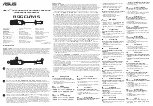
3.3 Angle of
Incidence
Fig. 8: Typical
microphone
position.
3.4 Feedback
Fig. 9: Microphone
placement for maxi-
mum gain before
feedback.
Refer to fig. 9.
Sing to one side of the micro-
phone or above and across
the microphone’s top. This
provides a well-balanced, nat-
ural sound.
If you sing directly into the
microphone, it will not only
pick up excessive breath
noise but also overemphasize
"sss", "sh", "tch", "p", and "t"
sounds.
Feedback is the
result of part of
the sound project-
ed by a speaker
being picked up
by a microphone,
fed to the amplifi-
er, and projected
again by the
speaker. Above a
specific volume or
"system gain"
sett i n g c a l l e d
the feedback threshold, the signal starts being regenerated
indefinitely, making the sound system howl and the sound
engineer desperately dive for the master fader to reduce the
volume and stop the howling.
To increase usable gain before feedback, the microphone has a
supercardioid polar pattern. This means that the microphone is
most sensitive to sounds arriving from in front of it (your voice)
while picking up much less of sounds arriving from the sides or
rear (from monitor speakers for instance).main ("FOH") speak-
ers in front of the microphones (along the front edge of the
stage).
If you use monitor speakers, be sure never to point any micro-
phone directly at the monitors, or at the FOH speakers.
Feedback may also be triggered by resonances depending on
the acoustics of the room or hall. With resonances at low fre-
quencies, proximity effect may cause feedback. In this case, it
is often enough to move away from the microphone a little to
stop the feedback.
3 Using Your Microphone
18
Содержание C 5900-TM 40
Страница 62: ...62 Notizen Notes Notes Note Notas Notas...
Страница 63: ...63 Notizen Notes Notes Note Notas Notas...
















































